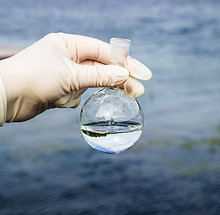
MARINE
UMD
GEMSTONE TEAM
Class of 2024
Research problem
Plastic: one of humanity’s most beloved inventions: we ride on it in our cars and our buses, we rely on it to keep our food fresh, and we save people using plastic safety gear and medical tools. The list goes on and on. There is no other material that humans have so deeply woven into our lives. We use plastics so readily and so often that it might actually be impossible to stop. 7.7 million square miles of Pacific water are littered with an unimaginable amount of plastic debris in the form of microplastics. This is slightly larger than the entire land area of Canada and the United States, combined. These microplastics are plastic pieces smaller than 5 millimeters in length and can come from sources such as being weathered down from larger debris or even being manufactured as tiny microbeads which are used in consumer products such as some kinds of toothpaste. Microplastics are a great concern simply due to how little is known about how they interact with the environment, wildlife, and with humans. They have been found in human blood, babies, and people’s lungs. They are found in both water and air. The very things which humans need for survival are polluted with microplastics. Research suggests connections between plastic ingestion and adverse health impacts which makes quantifying the amount of microplastics in our ecosystems vital. We want to explore the local watershed of UMD and characterize the microplastics situation from the perspective of suburban campus impacts.
Research Questions
Which method yields the most accurate data, when collecting, purifying, quantifying, and classifying microplastic samples?
What are the primary sources of microplastics entering the Anacostia/Potomac watershed (ultimately the Chesapeake Watershed)?
Mission Statement
Identify and map point sources in the Anacostia watershed local to our UMD campus


Develop a standardized methodology for microplastic detection
TimeLine

SPRING 2022
Research Proposal

SUMMER 2022
Collect Samples and Begin Analysis

SPRING 2023
End Data Collection
Continue Sample Analysis

FALL 2023
Data Analysis
Draft Thesis

LATE SPRING 2022
Begin Collecting Samples in the Anacostia

FALL 2022
Sample Collection and Analysis
Do Good Showcase

SUMMER 2023
Sample Counting through Fluorescent Microscopy
FAQ
Microplastics are plastic pieces smaller than 5 mm in length.
Microplastics can come from the degradation of larger plastic products or they can be manufactured as microplastics in the form of microbeads, which were often used in products like toothpaste or cosmetics.
The specific human health impacts caused by microplastics are not fully confirmed through completed studies yet. Early research suggests that there may be impacts to the gut microbiome and respiratory system. It’s important to understand where microplastics are entering the ecosystem and at what rate, so that when the impacts are confirmed, we know where regulations and prevention efforts are required.
They are ubiquitous in the environment and have even been found in human blood, lungs, and newborn babies.
Plastics are intended to be very durable which means they break down into smaller pieces but don’t fully degrade. The bonds in plastic are “xenobiotic” which means they are foreign to nature. They only degrade very slowly through means such as heat, oxidation, light, hydrolysis, or some microorganisms.
Microplastics are in our water and also in our food chain. One common method is through seafood. Sealife can ingest the microplastics, accumulating them at larger concentrations, and then humans consume them as food products.


















Meet The Team

Alana Ginsburg

Julia Grafstein

Cameron Hobbs

Joshua DiGiorgio
Team Financial Liaison

Lindsey Parker

Robert Pang

Fiona (Quin) Zabel
Team Library Liaison

Jonah Pereyra
Team Liaison

Dr. Lance Yonkos
Team Mentor
Benjamin Shaw
Team Librarian


